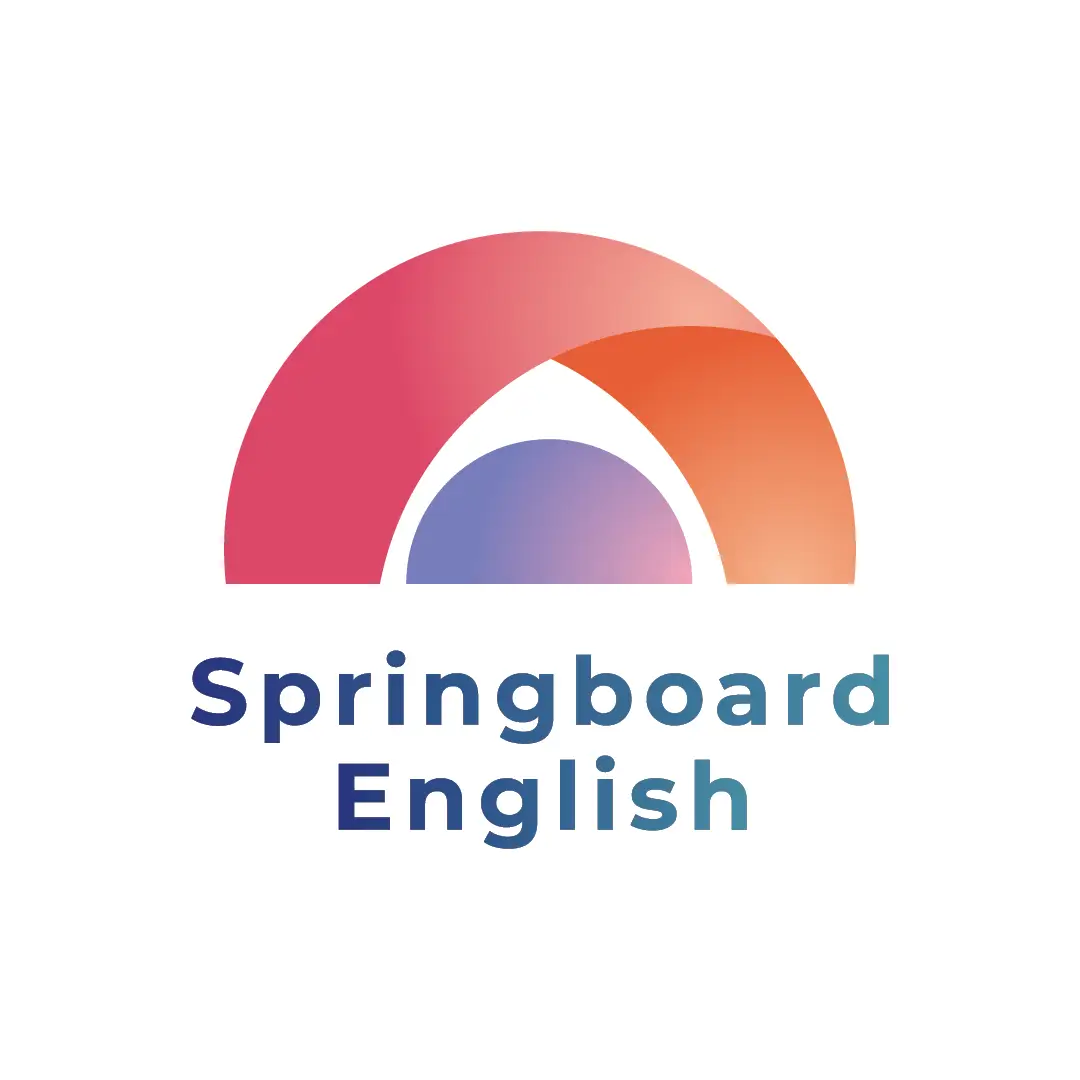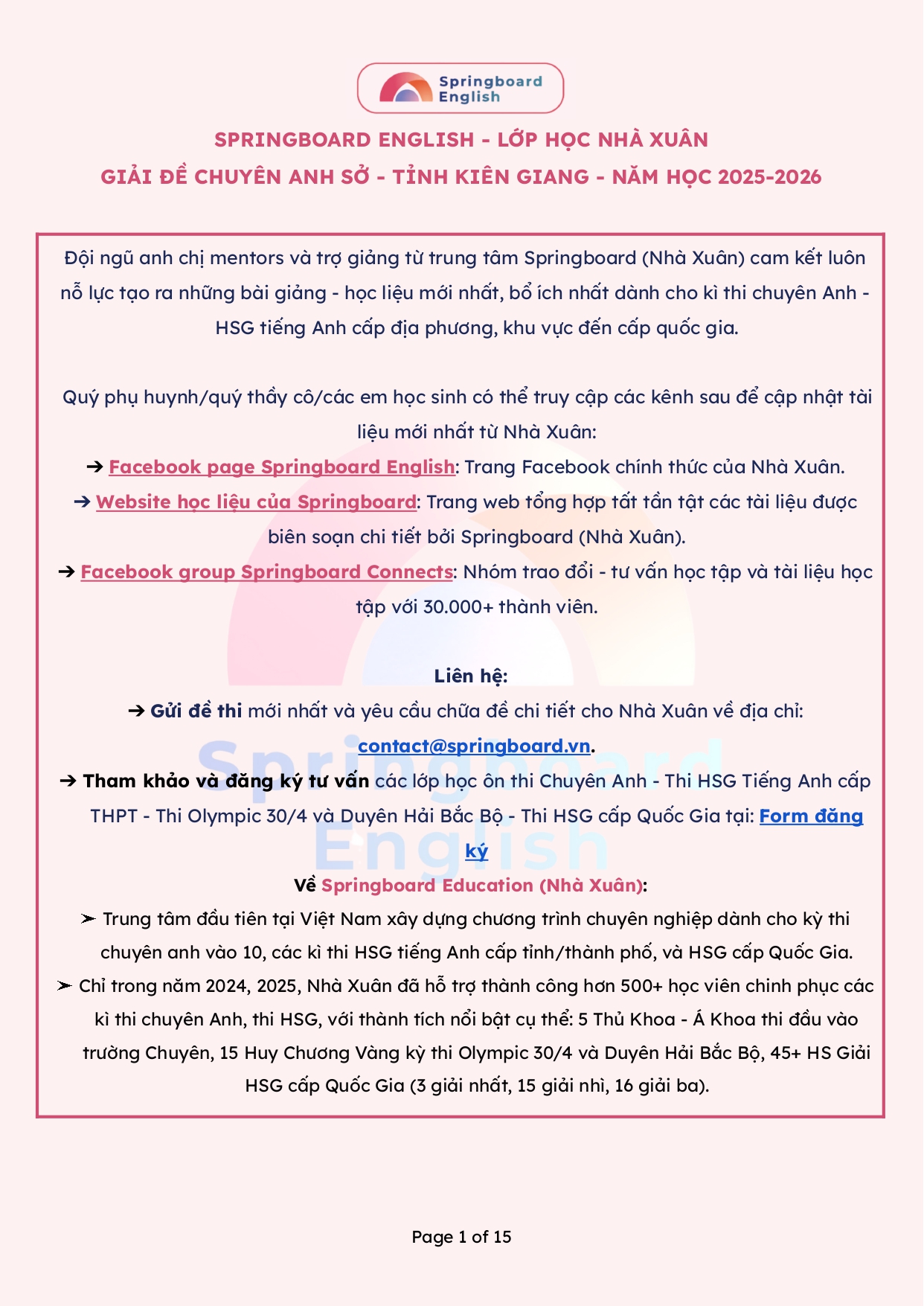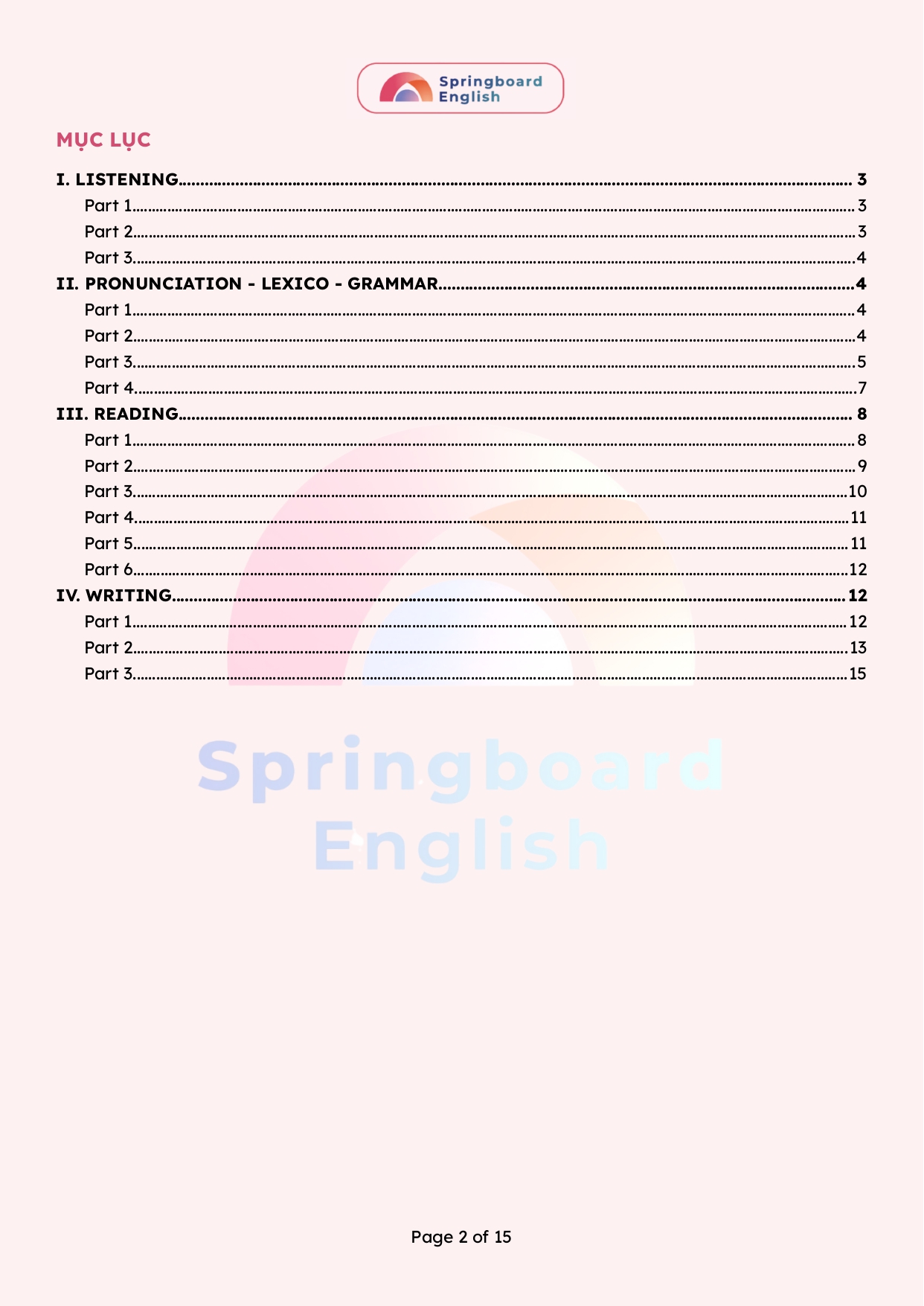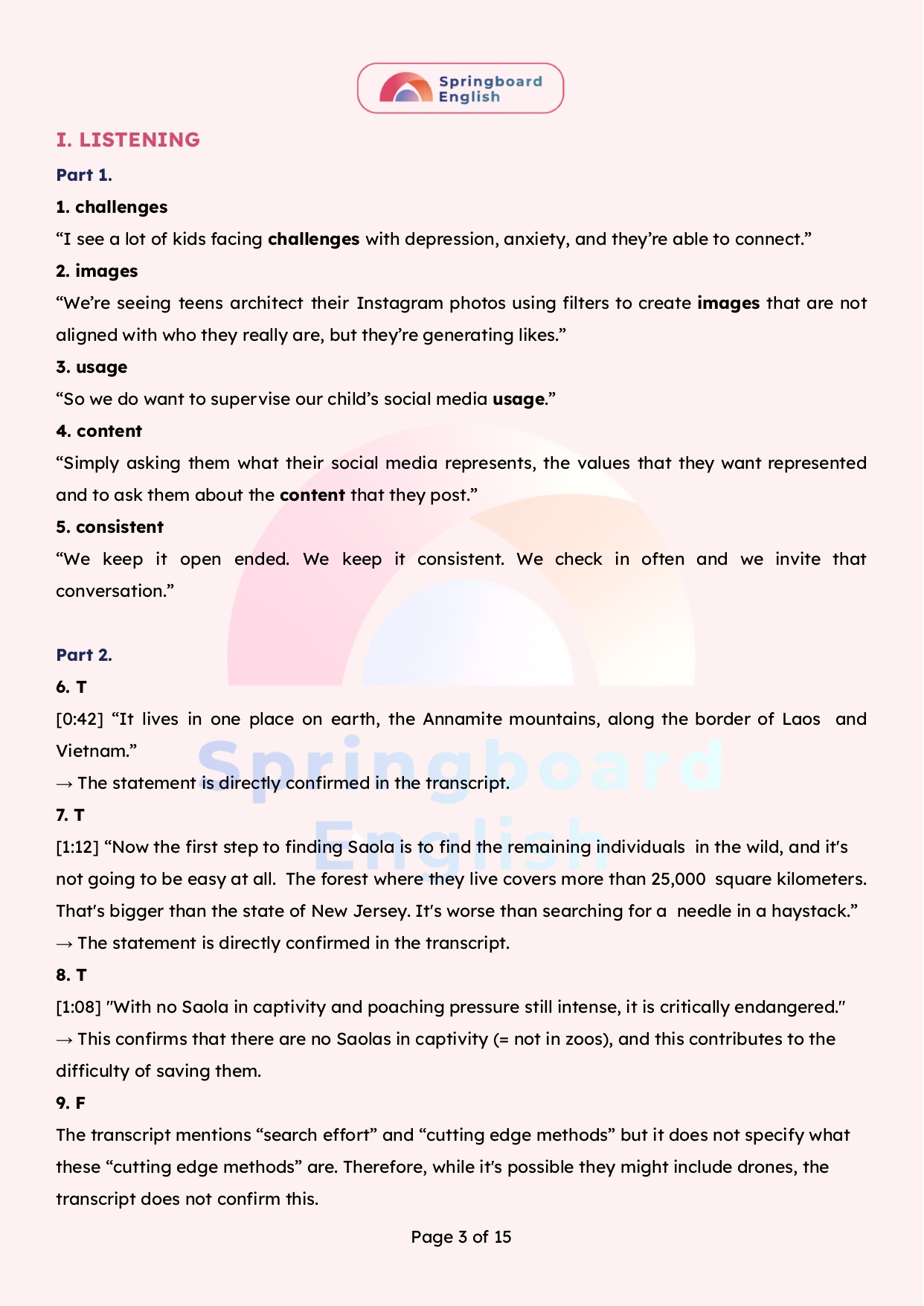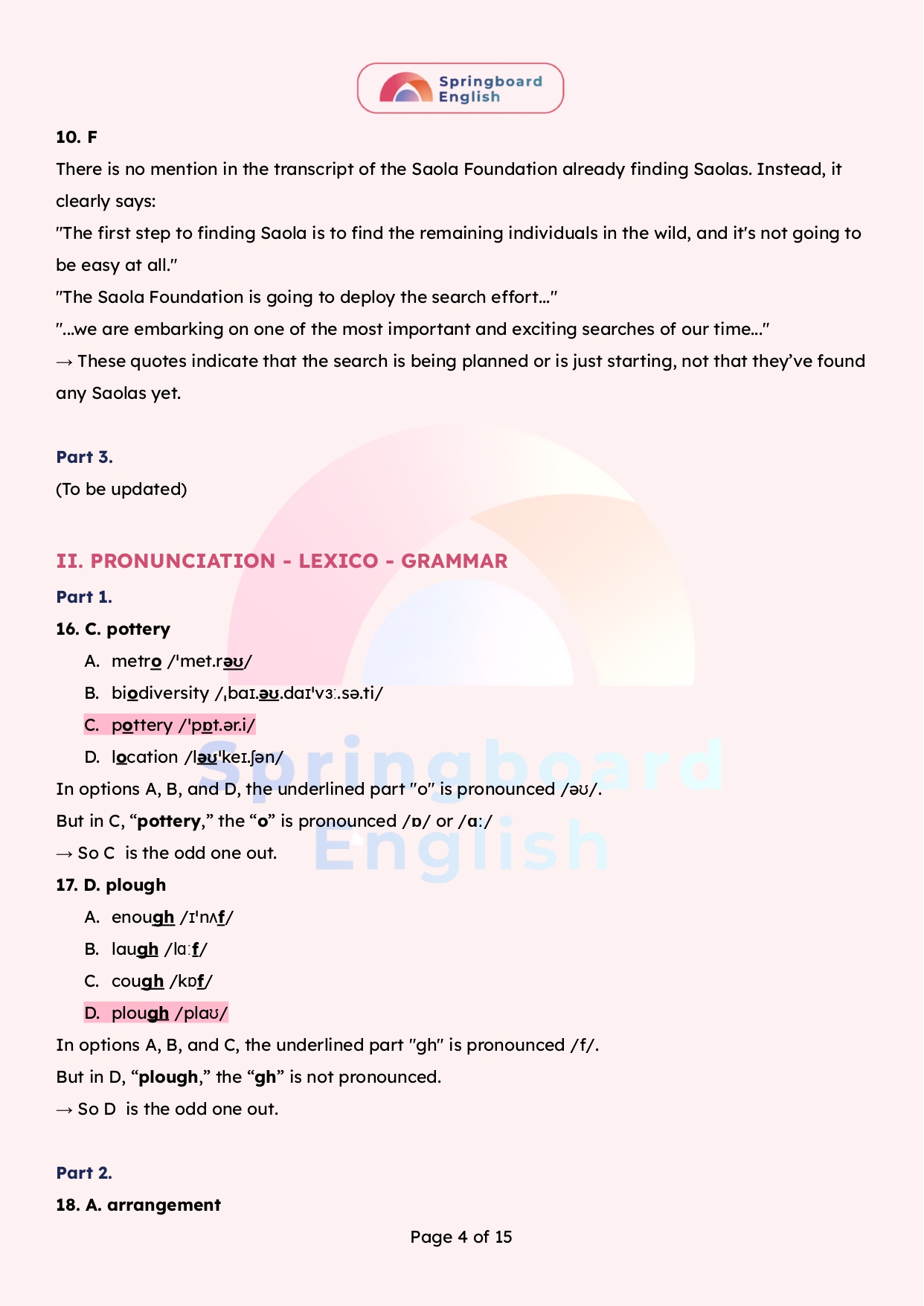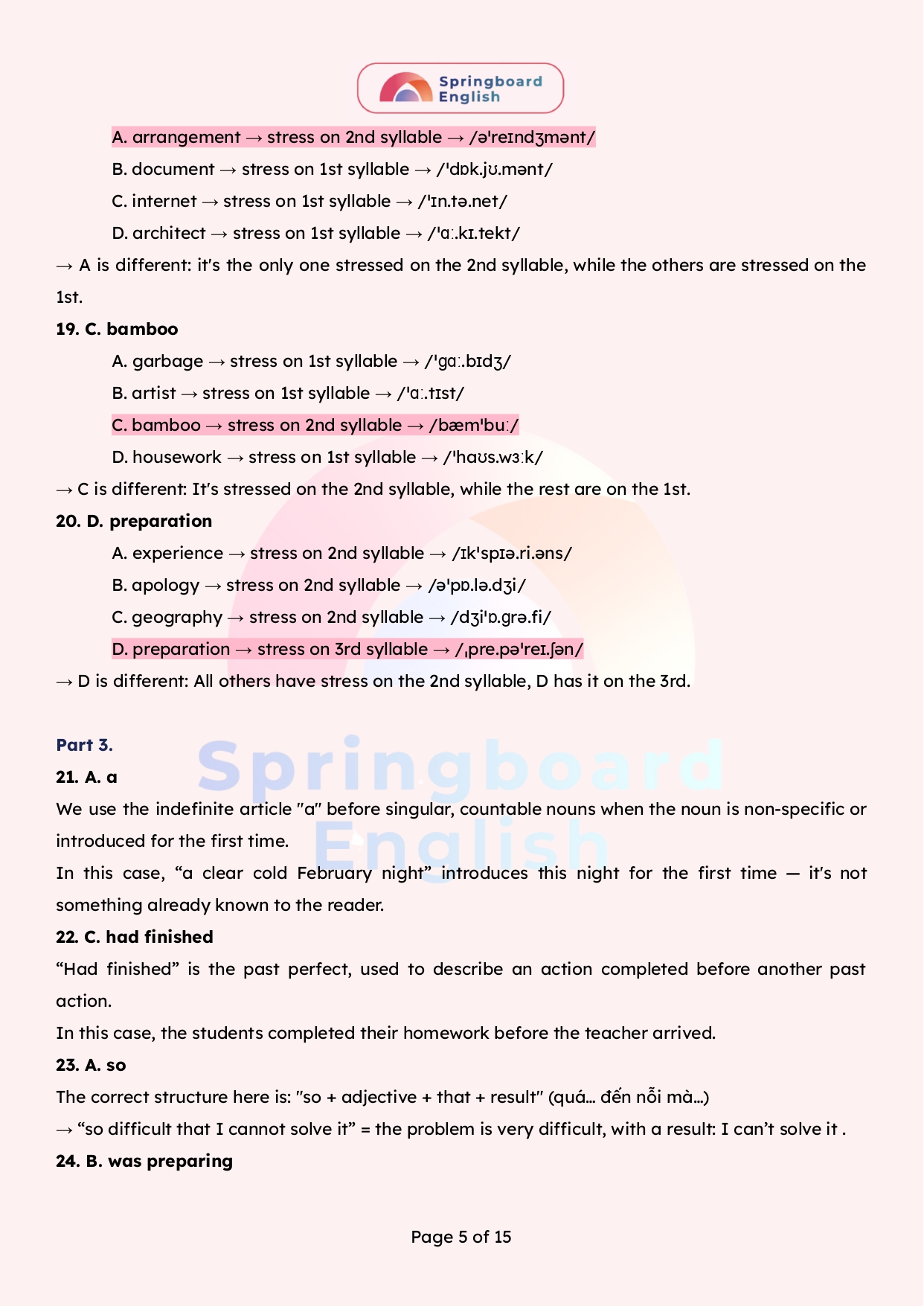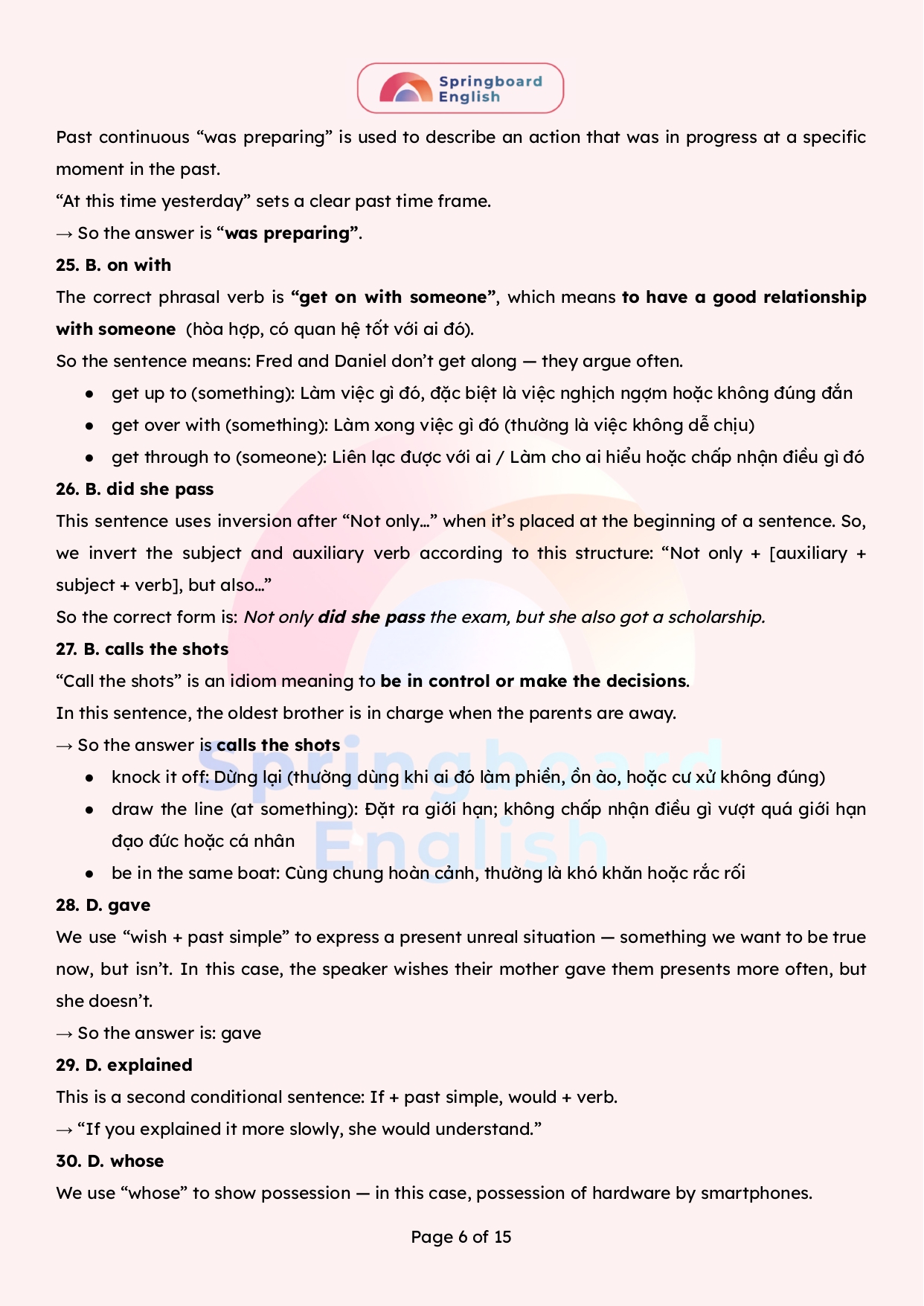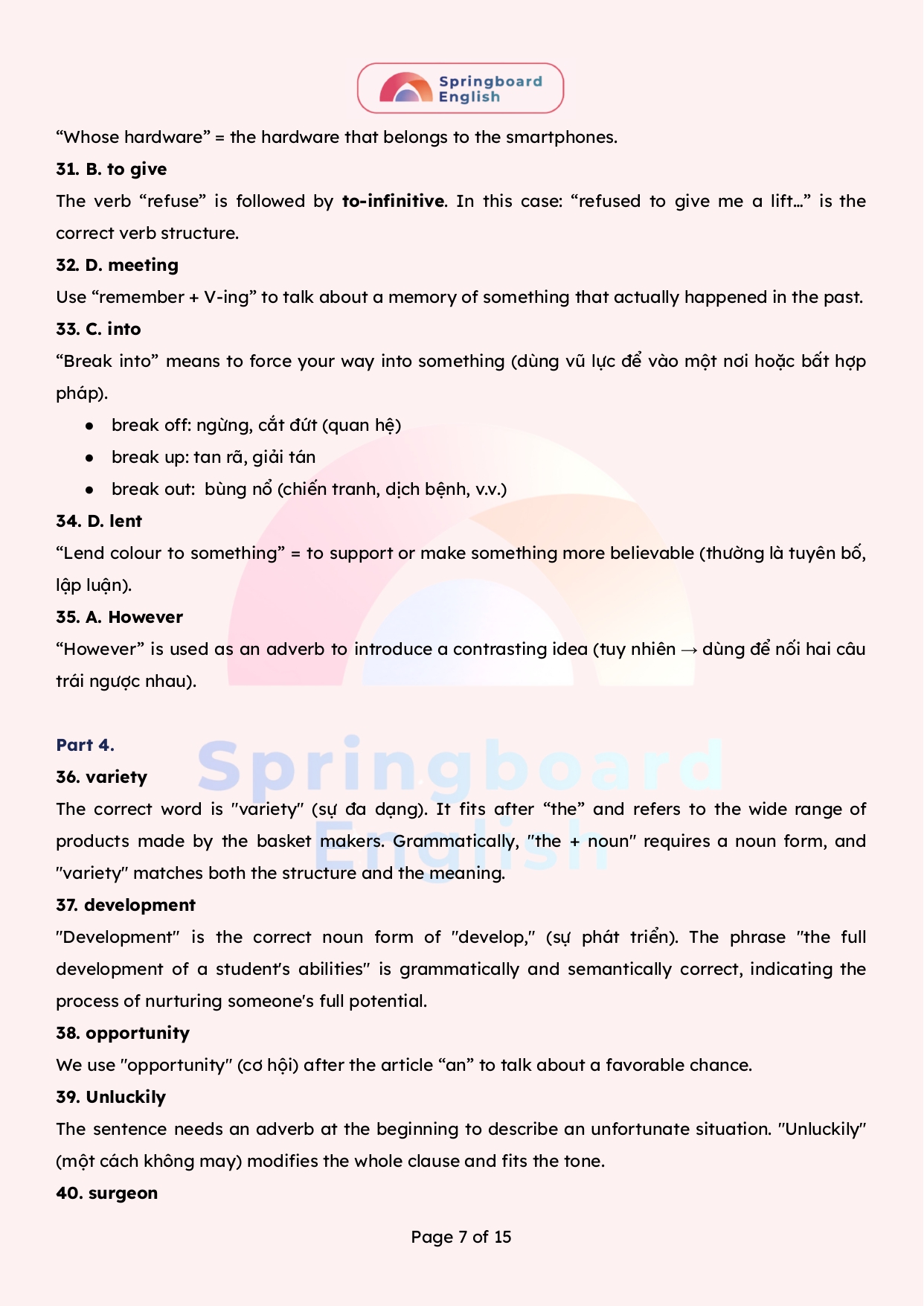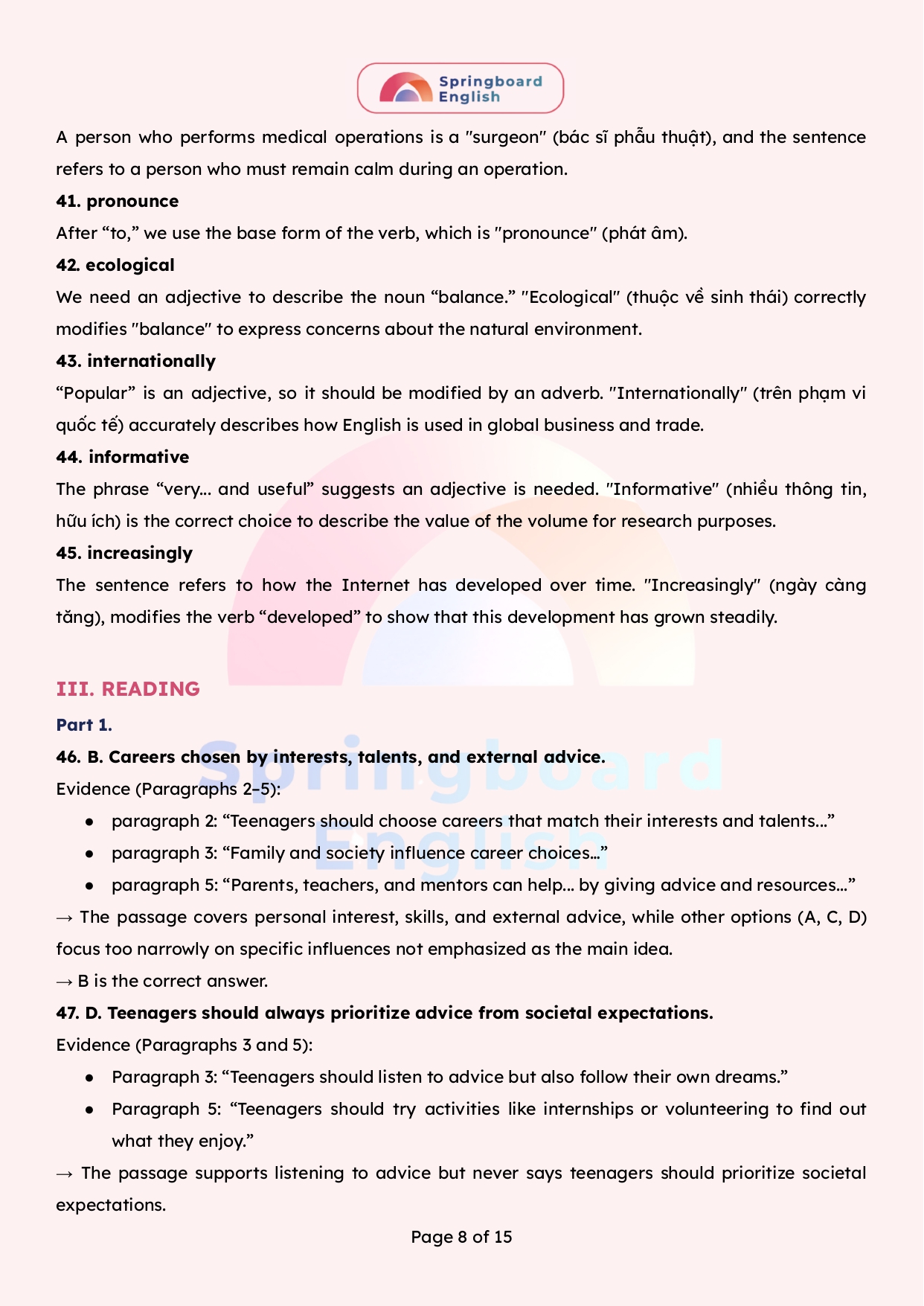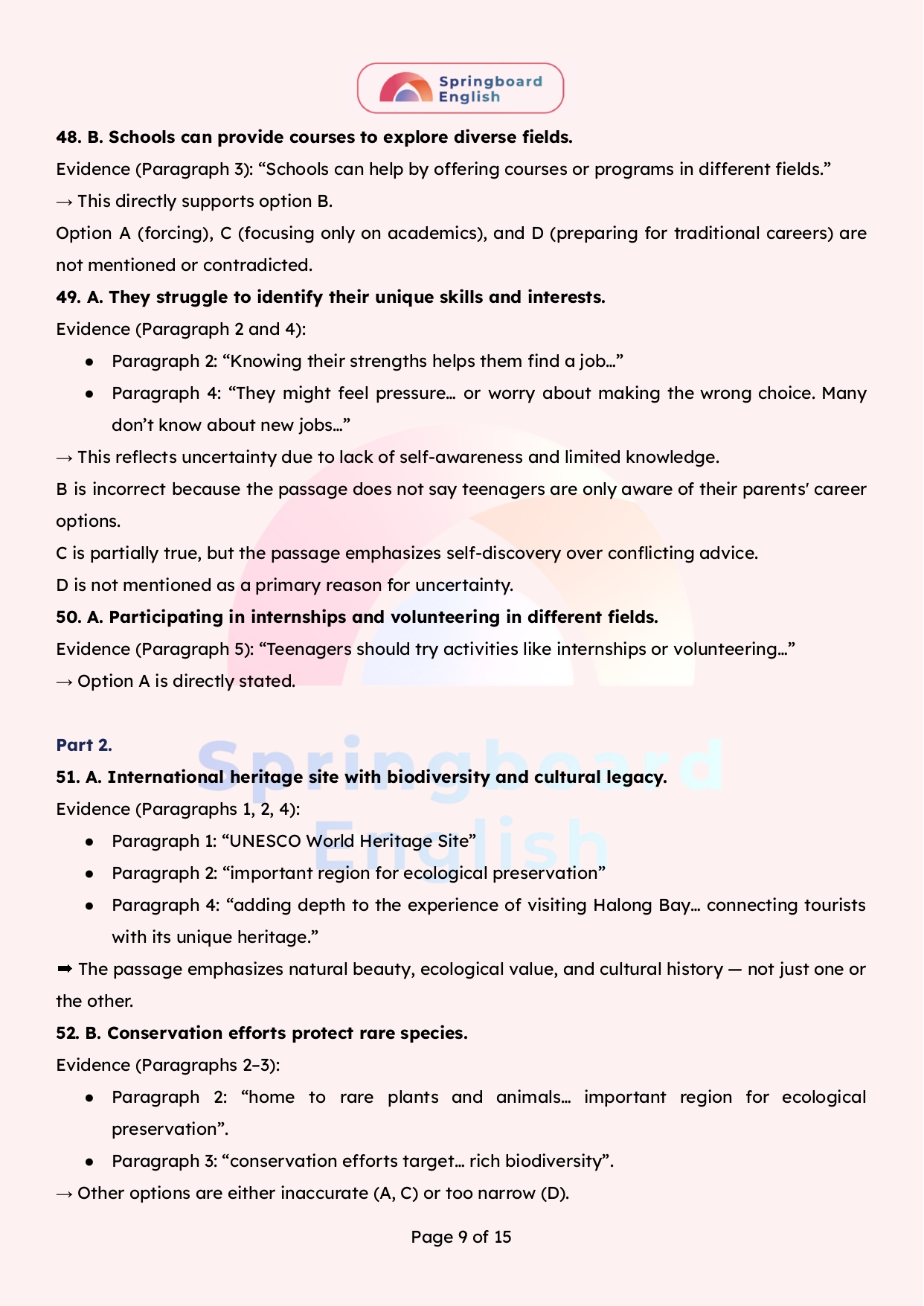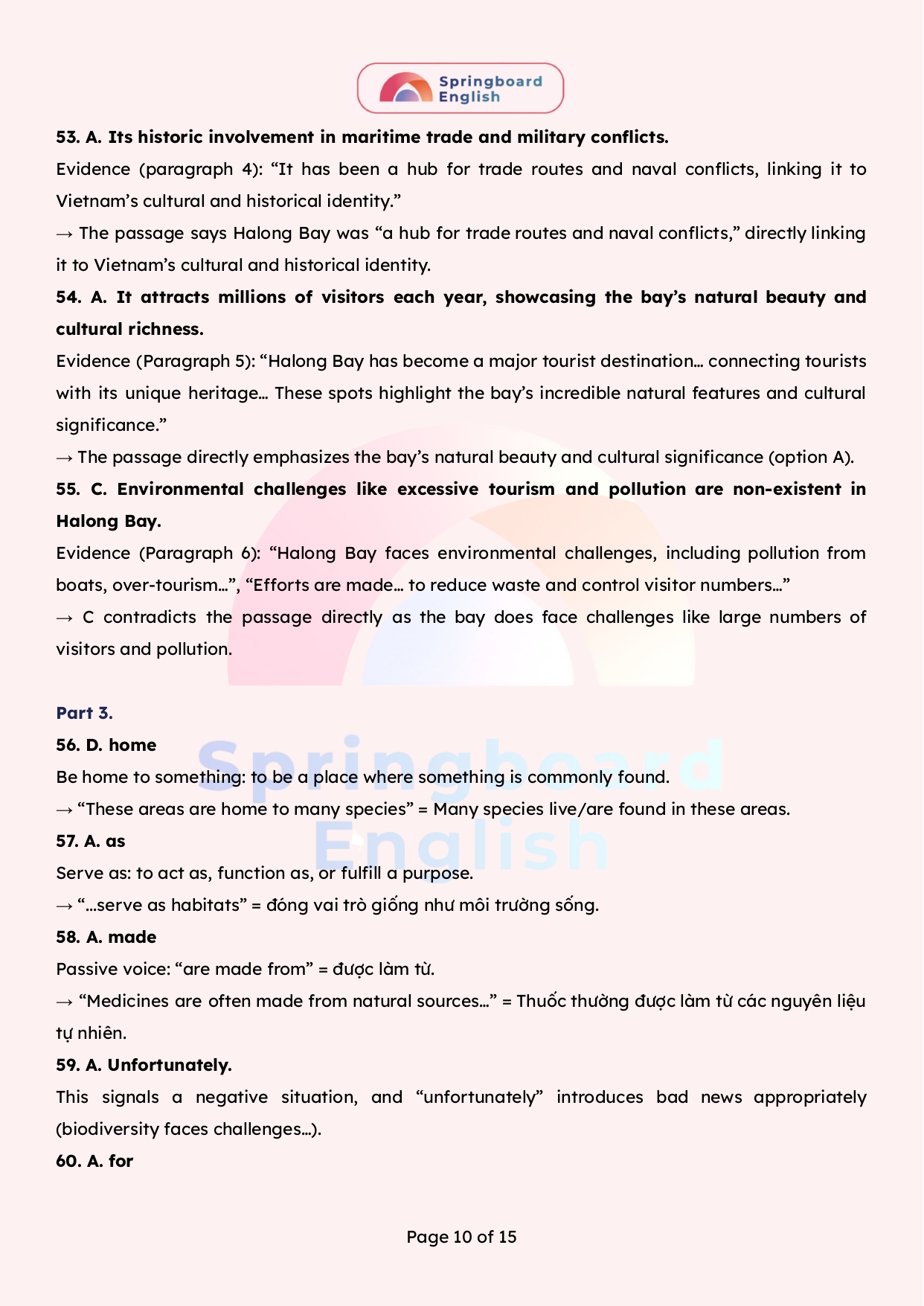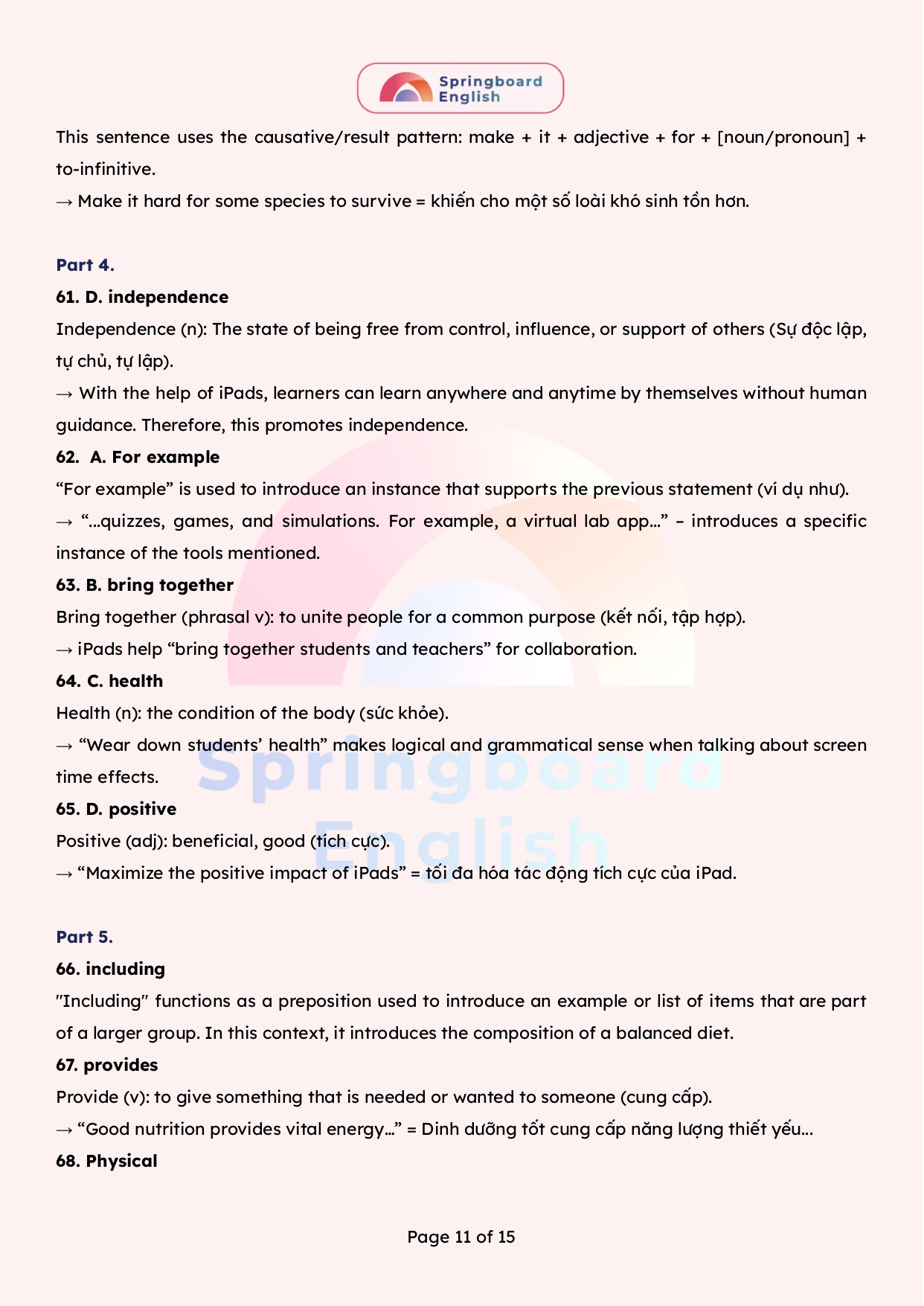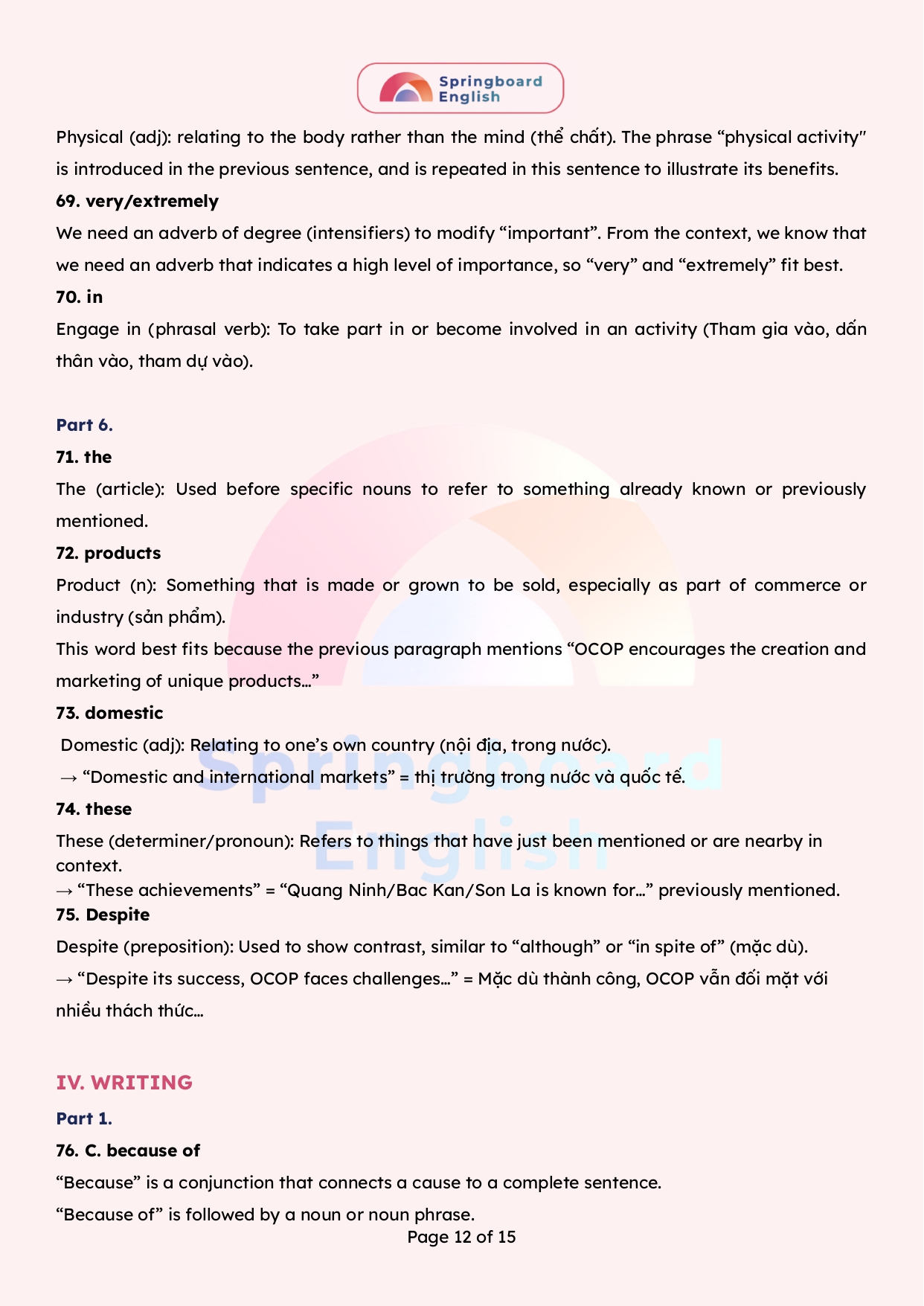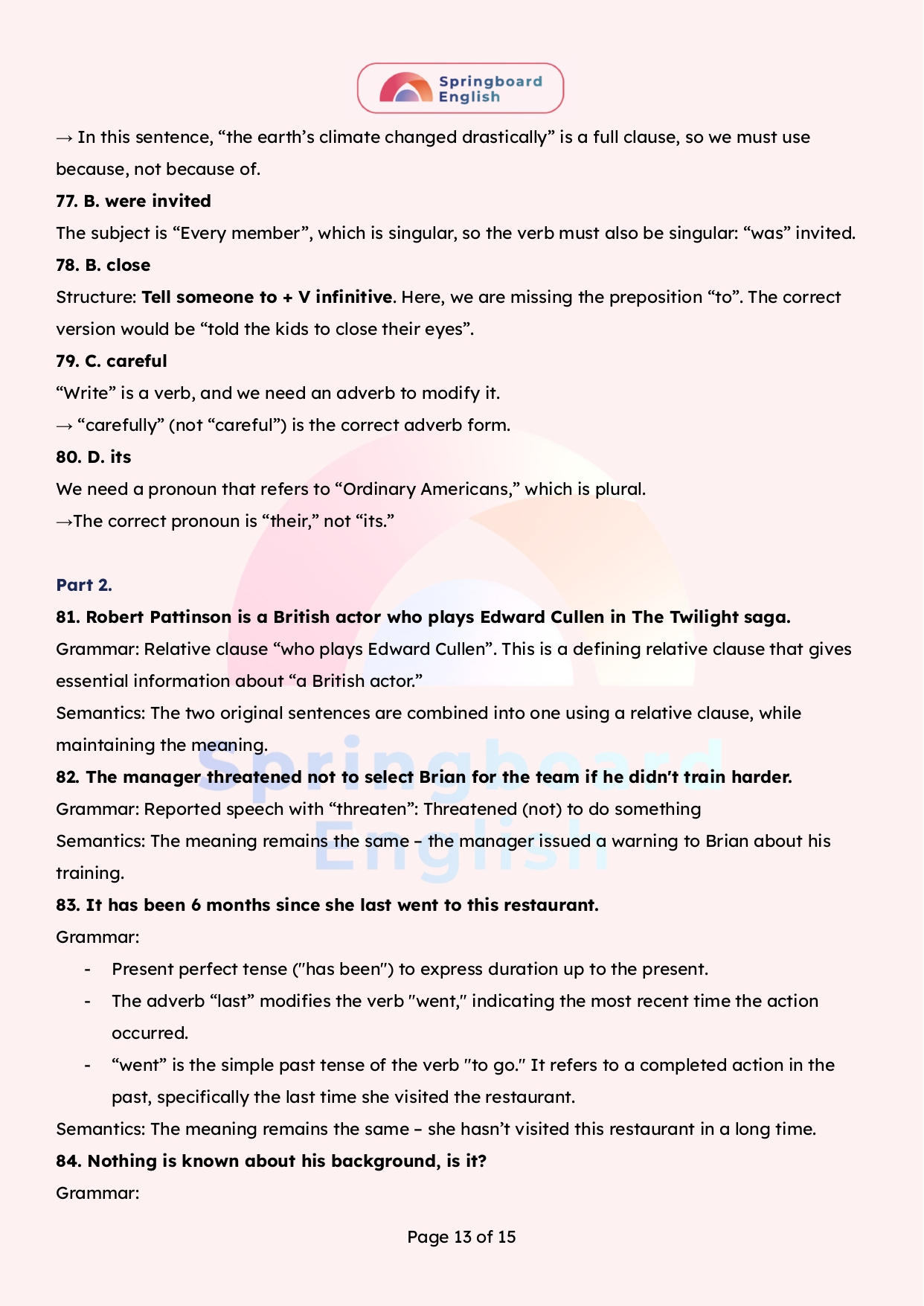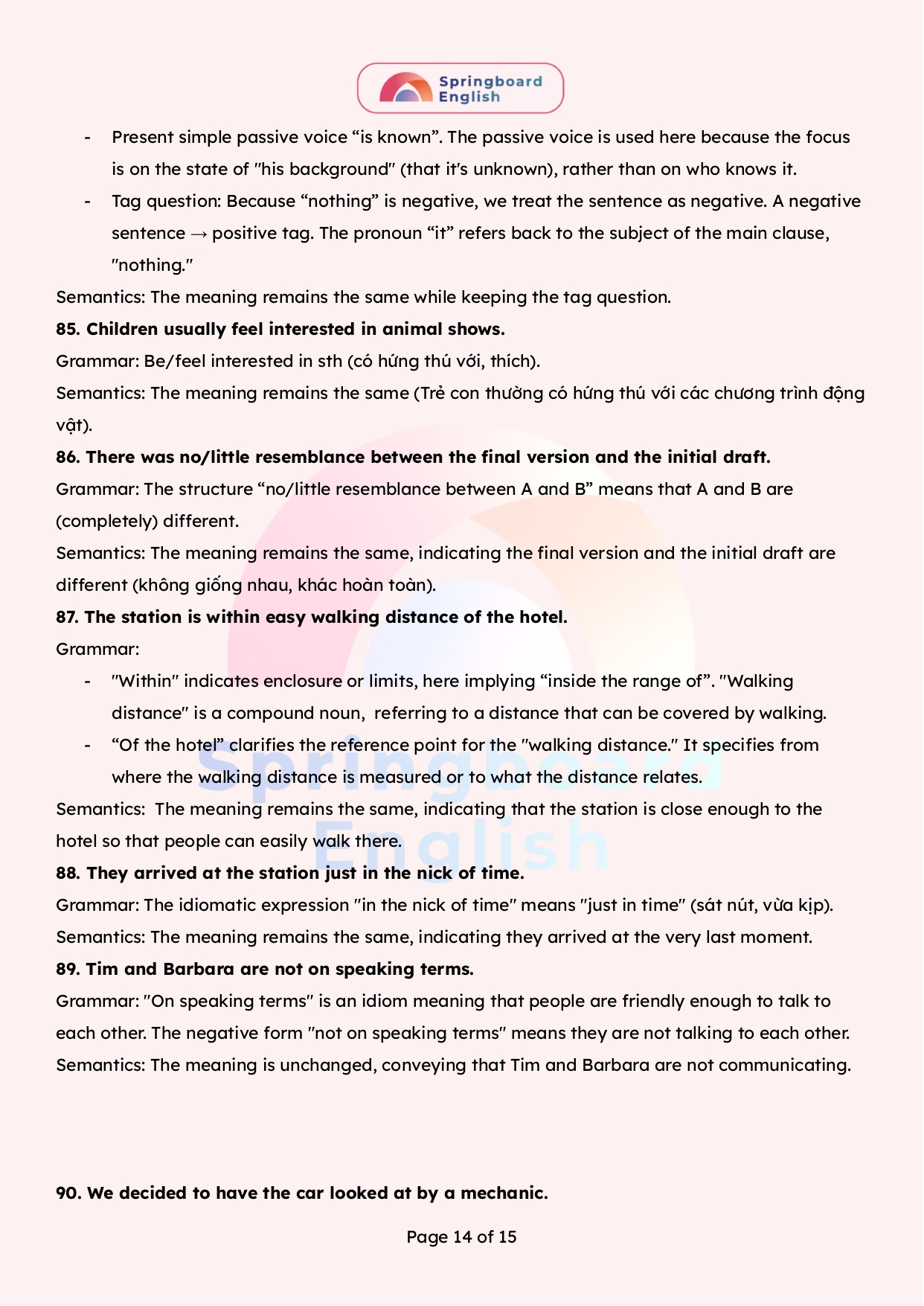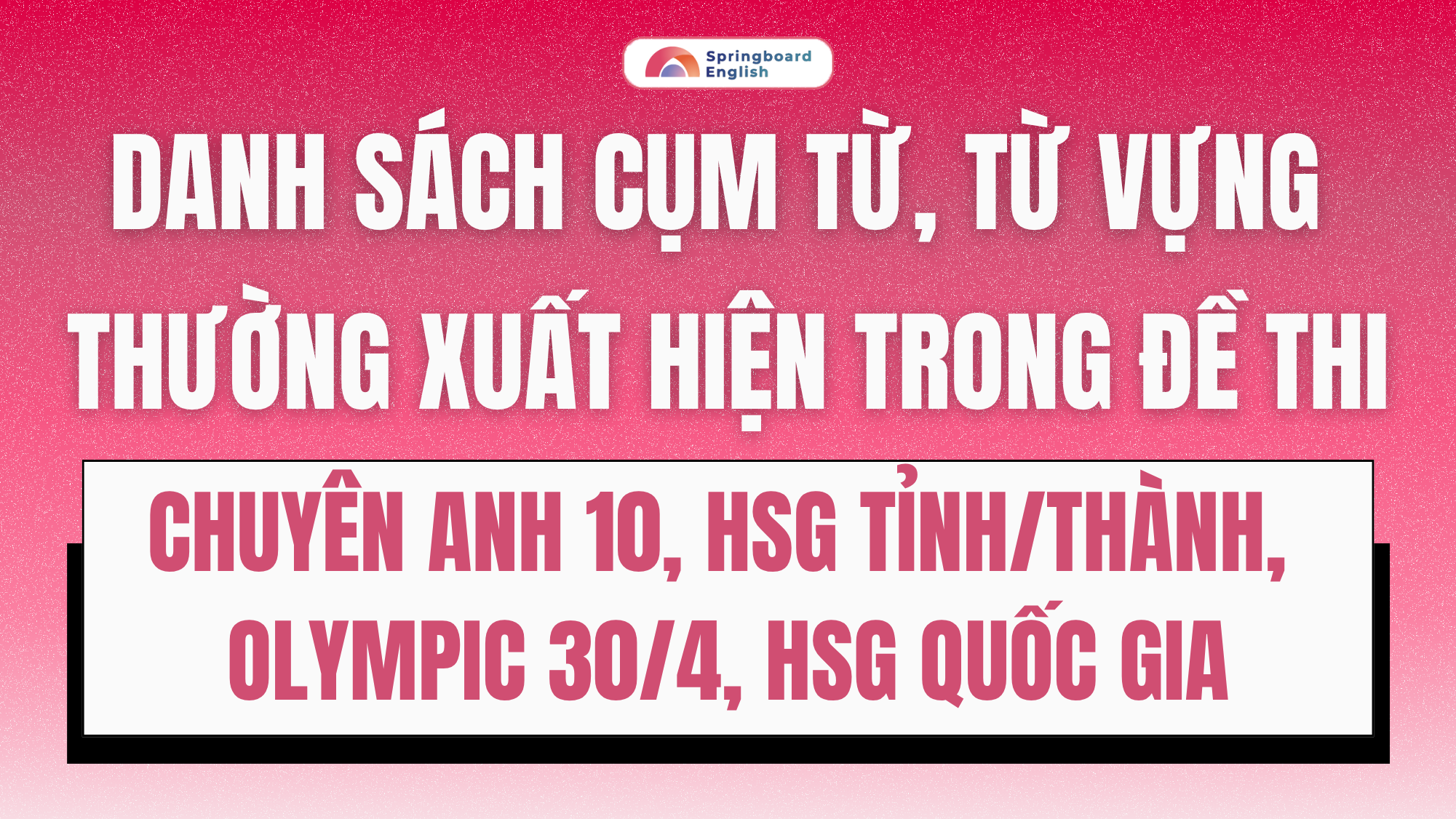Đề thi và Đáp án Chi tiết Kì thi Chuyên Anh 10, Chuyên Anh tỉnh Kiên Giang năm 2025-2026
Đội ngũ anh chị trung tâm Springboard (Nhà Xuân) xin gửi đến các quý phụ huynh, thầy cô, các em học sinh tổng hợp đề thi và đáp án đề thi Chuyên Anh vào lớp 10 tỉnh KIÊN GIANG, thi vào THPT Chuyên Huỳnh Mẫn Đạt năm 2025-2026 (có đáp án và giải thích chi tiết).
Phần đáp án chi tiết được giới thiệu ở bài viết này là tài liệu được biên soạn trực tiếp bởi đội ngũ chuyên môn Nhà Xuân, đồng thời là bản cập nhật mới nhất trong năm 2025.
Kéo xuống dưới cùng để xem hết đáp án có giải thích chi tiết.
Đề thi Chuyên Anh vào 10, Chuyên Anh tỉnh Kiên Giang năm 2025-2026
| SỞ GIÁO DỤC VÀ ĐÀO TẠO KIÊN GIANG ĐỀ CHÍNH THỨC | KỲ THI TUYỂN SINH VÀO LỚP 10 THPT CHUYÊN NĂM HỌC 2025 – 2026 MÔN THI: TIẾNG ANH (CHUYÊN) (Đề thi có 12 trang) Thời gian làm bài: 150 phút (không kể thời gian phát đề) Ngày thi: 31/5/2025 |
I. LISTENING (15 points) Part 1. Questions 1 – 5 (5 points) For questions: 1 – 5, listen to the recording TWICE and fill in each gap with ONE WORD from the recording. Write your answers in the corresponding numbered boxes. Teenagers are using social media in a plethora of really positive ways. There are groups, there are clubs out there to address anything that a teen has interest with. I see a lot of kids facing (1) ______ with depression, anxiety, and they’re able to connect. I think it’s incredibly important that we’re using social media appropriately. We’re seeing teens architect their Instagram photos using filters to create (2) ______ that are not aligned with who they really are, but they’re generating likes. It’s a social currency and it’s addictive. Sometimes teens make bad decisions and they can post things on social media that they don’t realize that exists forever, as adults. Employers look at social media and what are you posting on there? Kids aren’t thinking about those kinds of things. So we do want to supervise our child’s social media (3) ______. Simply asking them what their social media represents, the values that they want represented and to ask them about the (4) ______ that they post. Why is it important? What’s interesting about it? Coming from a place of genuine, authentic interest, right? Not concern, just interest. We start that conversation. We keep it open ended. We keep it (5) ______. We check in often and we invite that conversation. YOUR ANSWERS
| 1 | 2 | 3 | 4 | 5 |
Part 2. Questions 6 – 10 (5 points) For questions 6 – 10, listen to the recording TWICE and decide whether each of the following statements is True (T) or False (F). Write your answers in the corresponding numbered boxes.
- The Saola only lives in the Annamite Mountains, which are between Laos and Vietnam.
- Locating a Saola is even more challenging than finding a needle in a haystack.
- There are no Saolas in zoos, which makes saving them harder.
- The Saola Foundation will use drones to find the Saolas.
- The Saola Foundation has already found Saolas using their new methods.
| 6 | 7 | 8 | 9 | 10 |
Part 3. Questions 11 – 15 (5 points) For questions 11 – 15, listen to the recording TWICE and choose the letter (A, B, C or D) the best answer to each of the following questions. Write your answers in the corresponding numbered boxes.
- What is considered a key advantage of city life according to the recording?
| A. Vibrant social scenes with bars and restaurants |
| B. Diverse job opportunities for various skill levels |
| C. Well-connected public transport systems |
| D. Vibrancy and cultural activities |
- Which aspect of city living provides convenience for daily needs?
| A. The presence of theaters and concerts |
| B. A variety of shops, eateries, and franchises |
| C. Well-connected public transport systems |
| D. Abundance of job opportunities |
- Which of the following is NOT mentioned as a challenge of city life?
| A. Pollution |
| B. High cost of living |
| C. Lack of a strong sense of community |
| D. Availability of public transport |
- Which of the following is mentioned as a benefit of living in the countryside?
| A. Availability of abundant job opportunities |
| B. Clean, fresh air and stronger community connections |
| C. Easy access to public transport |
| D. Lively evening activities |
- What factors might influence the choice between living in the city and the countryside?
| A. Availability of job opportunities and transport facilities |
| B. Pollution levels and cost of living |
| C. Access to vibrant activities and strong community connections |
| D. Individual preferences and specific lifestyle requirements |
| 11 | 12 | 13 | 14 | 15 |
II. PRONUNCIATION – LEXICO – GRAMMAR (30 points) Part 1. Questions 16 – 17 (2 points) For questions 16 – 17, choose the letter (A, B, C or D) to indicate the word whose underlined part differs from the other three in pronunciation in each of the following questions. Write your answers in the corresponding numbered boxes.
- A. metro B. biodiversity C. pottery D. location
- A. enough B. laugh C. cough D. plough
| 16 | 17 |
Part 2. Questions 18 – 20 (3 points) For questions 18 – 20, choose the letter (A, B, C or D) to indicate the word whose primary stress differs from the other three in each of the following questions. Write your answers in the corresponding numbered boxes.
- A. arrangement B. document C. internet D. architect
- A. garbage B. artist C. bamboo D. housework
- A. experience B. apology C. geography D. preparation
| 16 | 17 | 18 | 19 | 20 |
Part 3. Questions 21 – 35 (15 points) For questions 21 – 35, choose the letter (A, B, C or D) to indicate the best answer to each of the following questions. Write your answers in the corresponding numbered boxes.
- I paid my first visit to them on ______ clear cold February night.
| A. a |
| B. an |
| C. the |
| D. Ø |
- Before the teacher arrived, they ______ their homework.
| A. finished |
| B. have finished |
| C. had finished |
| D. finish |
- This problem is ______ difficult that I cannot solve it.
| A. so |
| B. such |
| C. too |
| D. enough |
- At this time yesterday, I ______ for my son’s birthday party.
| A. prepared |
| B. was preparing |
| C. was prepared |
| D. were preparing |
- I don’t think Fred gets ______ Daniel. They always argue.
| A. up to |
| B. on with |
| C. over with |
| D. through to |
- Not only ______ the exam but she also got a scholarship.
| A. will she pass |
| B. did she pass |
| C. she passed |
| D. has she passed |
- Whenever his parents are away, his oldest brother ______.
| A. knocks it off |
| B. calls the shots |
| C. draws the line |
| D. is in the same boat |
- I wish my mother ______ me presents more often.
| A. gives |
| B. will give |
| C. would give |
| D. gave |
- She would understand the problem if you ______ it to her more slowly.
| A. explains |
| B. can explain |
| C. would explain |
| D. explained |
- All smartphones ______ storage hardware is big can store downloaded audio books.
| A. which |
| B. who |
| C. whose |
| D. that |
- I was very angry. My friend John refused ______ me a lift as he had promised.
| A. give |
| B. to give |
| C. giving |
| D. gave |
- I remember ______ you somewhere last month.
| A. met |
| B. to meet |
| C. meet |
| D. meeting |
- The firemen had to break ______ the room to rescue the children.
| A. off |
| B. up |
| C. into |
| D. out |
- At first, no one believed that she was a pilot, but her documents ______ colour to her statements.
| A. provided |
| B. got |
| C. borrowed |
| D. lent |
- Phong had a terrible headache. ______, he went to school on time.
| A. However |
| B. But |
| C. Therefore |
| D. Although |
| 21 | 22 | 23 | 24 | 25 | 26 | 27 | 28 | 29 | 30 | 31 | 32 | 33 | 34 | 35 |
Part 4. Questions 36 – 45 (10 points) For questions 36 – 45, use the correct form of the words in capitals to complete each gap in each of the following sentences. Write your answers in the corresponding numbered boxes.
- I was still amazed at the ______ of products made by the basket makers there. (VARY)
- Schools should encourage the full ______ of a student’s abilities. (DEVELOP)
- Studying in Singapore will give you a(n) ______ to practice English. (OPPORTUNE)
- ______, our flight was cancelled and we had to spend one night at the airport. (LUCKY)
- A/An ______ must be able to keep calm while performing a medical operation. (SURGERY)
- I found it difficult to ______ the name of the port. (PRONUNCIATION)
- We risk upsetting the ______ balance of the area. (ECOLOGY)
- English has long been ______ popular in business and trading. (NATION)
- This volume is very ______ and useful for your research. (INFORM)
- The Internet has ______ developed and become part of our everyday life. (INCREASE)
| 36 | 37 | 38 | 39 | 40 |
| 41 | 42 | 43 | 44 | 45 |
III. READING (30 points) Part 1: (5 points) For questions 46 – 50, read the passage and choose the best answer (A, B, C or D) for each question according to the passage. Write your answers in the corresponding numbered boxes. Choosing a career is one of the most important decisions for teenagers. It helps them learn about themselves and their future. Many things affect their choice, like what they enjoy, their skills, and advice from family or friends. Teenagers need to think about these factors and make a choice that feels right for them. Teenagers should choose careers that match their interests and talents. If they enjoy art, they can explore jobs like graphic design. If they are good at science, they might want to be researchers or engineers. Knowing their strengths helps them find a job they will enjoy and find success in. Sometimes, family and society influence career choices. Parents may want their children to follow certain paths, like medicine or law. Teenagers should listen to advice but also follow their own dreams. Schools can help by offering courses or programs in different fields. Teenagers face challenges when choosing careers. They might feel pressure from parents or worry about making the wrong choice. Many don’t know about new jobs, like working in technology or the environment. It’s important to learn about different options and understand that career paths can change over time. Parents, teachers, and mentors can help teenagers by giving advice and resources. Teenagers should try activities like internships or volunteering to find out what they enjoy. Learning about exciting fields like robotics or renewable energy can also guide them. Choosing a career is a step toward their future, and they should see it as an opportunity to grow and learn.
- Which of the following best summarizes the passage?
| A. Career choices based on societal and family pressures. |
| B. Careers chosen by interests, talents, and external advice. |
| C. Parents ensuring children pick high-paying jobs. |
| D. Schools enforcing specific career paths. |
- Which of the following is NOT mentioned in the passage regarding teenagers and career choices?
| A. Teenagers often face pressure from parents when making career decisions. |
| B. Schools can introduce teenagers to diverse career fields through specialized programs. |
| C. Teenagers may worry about choosing the wrong career path. |
| D. Teenagers should always prioritize advice from societal expectations. |
- How does the passage describe the role of schools in helping teenagers with career choices?
| A. Schools should enforce specific career paths for success. |
| B. Schools can provide courses to explore diverse fields. |
| C. Schools should focus solely on academics. |
| D. Schools should prepare students for traditional careers. |
- Based on the passage, why might teenagers feel uncertain about their career choices?
| A. They struggle to identify their unique skills and interests. |
| B. They are only aware of career choices that existed in their parents’ time. |
| C. They receive conflicting advice from family, society, and school mentors. |
| D. They worry about environmental and world challenges affecting their options. |
- What are some activities suggested in the passage to help teenagers explore career options?
| A. Participating in internships and volunteering in different fields. |
| B. Taking mandatory courses in robotics and renewable energy. |
| C. Avoiding any advice from parents and teachers. |
| D. Focusing only on academic achievements. |
| 46 | 47 | 48 | 49 | 50 |
Part 2: (5 points) For questions 51 – 55, read the passage and choose the best answer (A, B, C or D) for each question according to the passage. Write your answers in the corresponding numbered boxes. Halong Bay, located in northeast Vietnam, is celebrated for its emerald waters, towering limestone cliffs, and nearly 2,000 islands, making it one of the world’s most stunning destinations. Its name, “Halong”, meaning “Descending Dragon”, comes from a legend where dragons descended to create the islands as a natural defense against invaders. The bay’s unique geography and captivating landscape have earned it a spot as a UNESCO World Heritage Site. Beyond its beauty, Halong Bay hosts a rich ecosystem with limestone caves, coral reefs, and mangrove forests that support diverse wildlife. The area is home to rare plants and animals, both underwater and on land, making it an important region for ecological preservation. The delicate balance of nature here has drawn attention for conservation efforts to protect its biodiversity. Halong Bay’s ecosystem is diverse, featuring limestone caves, coral reefs, mangrove forests, and rare wildlife both underwater and on land. Conservation efforts target the preservation of this rich biodiversity, combating challenges such as pollution and the impacts of tourism. The bay is also steeped in history and folklore. Legends tell of dragons shaping the islands, while archaeological evidence suggests human activity dating back thousands of years. It has been a hub for trade routes and naval conflicts, linking it to Vietnam’s cultural and historical identity. These stories add depth to the experience of visiting Halong Bay, connecting tourists with its unique heritage. Halong Bay has become a major tourist destination, offering activities like boat cruises, cave exploration, and hiking on islands such as Cat Ba. Key attractions include Hang Sung Sot (Surprise Cave), Tuan Chau Island with its resorts and beaches, and Dau Go Cave with its fascinating formations. These spots highlight the bay’s incredible natural features and cultural significance. However, Halong Bay faces environmental challenges, including pollution from boats, over-tourism, and climate change. Efforts are underway to promote sustainable tourism by reducing waste, controlling visitor numbers, and encouraging eco-friendly practices. Preserving Halong Bay is vital to maintaining its beauty and ecological value for future generations, ensuring it remains a symbol of natural and cultural wonder.
- Which of the following best summarizes the passage?
| A. International heritage site with biodiversity and cultural legacy. |
| B. Historic trading post linked to naval battles. |
| C. Popular for resorts and beaches. |
| D. Named after folklore about dragons forming defenses. |
- Which of the following statements best reflects the ecological and conservation highlights of Halong Bay?
| A. Halong Bay has limited biodiversity. |
| B. Conservation efforts protect rare species. |
| C. Tourism and pollution are no threat due to measures. |
| D. Ecological value lies in coral reefs and mangroves. |
- Which aspect of Halong Bay highlights its connection to Vietnam’s cultural identity?
| A. Its historic involvement in maritime trade and military conflicts. |
| B. Its scenic limestone cliffs and turquoise waters that define its landscape. |
| C. Its archaeological findings that document ancient marine ecosystems. |
| D. Its flourishing tourism industry that attracts millions of visitors annually. |
- How does Halong Bay’s tourism industry contribute to its global appeal?
| A. It attracts millions of visitors each year, showcasing the bay’s natural beauty and cultural richness. |
| B. It provides a platform for international studies on marine conservation efforts. |
| C. It limits access to certain areas to protect the bay’s ecosystems and heritage. |
| D. It primarily focuses on luxury resort development to accommodate high-end travelers. |
- Which of the following statements is NOT TRUE according to the passage?
| A. Halong Bay contains close to 2,000 islands scattered across its waters. |
| B. Archaeological studies reveal human settlements in the area dating back thousands of years. |
| C. Environmental challenges like excessive tourism and pollution are non-existent in Halong Bay. |
| D. The term “Halong” translates to “Descending Dragon” in Vietnamese. |
| 51 | 52 | 53 | 54 | 55 |
Part 3: (5 points) For questions 56 – 60, read the passage below and decide which answer (A, B, C or D) best fits each gap. Write your answers in the corresponding numbered boxes. Biodiversity refers to the variety of life on Earth, including different plants, animals, and ecosystems. It is important for the environment because it keeps nature balanced and healthy. Forests, oceans, and lakes are examples of places with lots of biodiversity. These areas are (56) ______ to many species that help the planet stay strong and productive. Biodiversity plays a big role in keeping ecosystems stable. It helps provide clean water, fresh air, and healthy soil. Bees and other insects, for example, pollinate plants so we can grow food. Wetlands clean water and serve (57) ______ habitats for many animals. When we lose biodiversity, these natural services become weaker, which can harm the planet and people. Humans benefit from biodiversity in many ways. It supports farming, fishing, and tourism, which bring money and jobs. Medicines are often (58) ______ from natural plants and animals found in biodiverse areas. Enjoying nature, like hiking in forests or diving in coral reefs, also makes people feel happier and more connected to the world. (59) ______ biodiversity faces threats such as deforestation, pollution, and climate change. Building cities and cutting down forests destroy habitats. Chemicals in water and soil hurt plants and animals. Rising temperatures also affect ecosystems, making it hard (60) ______ some species to survive. Protecting biodiversity is essential for the future of both nature and humans.
- A. place B. building C. office D. home
- A. as B. like C. same D. similar
- A. made B. making C. being made D. make
- A. Unfortunately B. Fortunately C. Luckily D. Happily
- A. for B. to C. in D. of
| 56 | 57 | 58 | 59 | 60 |
Part 4: (5 points) For questions 61 – 65, read the passage below and decide which answer (A, B, C or D) best fits each gap. Write your answers in the corresponding numbered boxes.
iPads have shaken up the education system by providing students and educators with accessible and portable tools. Instead of lugging around heavy books, learners can tap into educational apps, e-books, and resources with ease. This ease of use helps learners keep up with their studies anytime and anywhere, promoting (61) ______ and adaptability.
The interactive features of iPads make education more engaging. Apps tailored for subjects like languages and science often come up with dynamic experiences through quizzes, games, and simulations (62) ______, a virtual lab app can help science students carry out experiments that would otherwise be difficult to perform in a traditional classroom setting.
iPads also help (63) ______ students and teachers for better collaboration. Shared documents, cloud storage, and digital platforms allow group projects and assignments to be completed seamlessly. Educators can follow up on digital submissions quickly, improving communication and the learning process.
While iPads offer numerous benefits, issues like cost and excessive screen time must be dealt with. They are expensive for schools or families with limited budgets, and prolonged use can wear down students’ (64) ______, such as eye strain. Responsible usage and careful monitoring by parents and educators can help sort out these challenges and maximize the (65) ______ impact of iPads in education.
| 61. A. dependence | B. independent | C. dependent | D. independence |
| 62. A. For example | B. Such as | C. Therefore | D. However |
| 63. A. turn out | B. bring together | C. bring up | D. carry on |
| 64. A. muscles | B. strength | C. health | D. energy |
| 65. A. unmanageable | B. uncontrollable | C. unpredictable | D. positive |
Part 5: (5 points) For questions 66 – 70, complete the passage below by filling in each gap with ONE suitable word. Write your answers in the corresponding numbered boxes.
Living a healthy life is very important for teenagers as it helps them grow strong, feel good, and enjoy daily activities. Teens should eat a balanced diet (66) ______ fruits, vegetables, proteins, whole grains, and water, while limiting sugary, salty, and unhealthy fats found in snacks like chips and fast food. Good nutrition (67) ______ vital energy and supports the body’s functions.
Exercise is another key part of healthy living. Teens should aim for at least 60 minutes of physical activity each day, such as playing sports, walking, jogging, dancing, or swimming. (68) ______ activity strengthens muscles and bones, keeps the heart healthy, and improves mood and sleep quality. Staying active contributes significantly to overall well-being.
Sleep is (69) ______ important, with teenagers needing about 8 to 10 hours of rest each night. Sleep allows the mind to recharge, enhancing focus and energy for the next day. Creating a regular sleep schedule, avoiding screens before bedtime, and maintaining a calm sleep environment can greatly improve sleep quality. Adequate rest is crucial for mental and physical health.
Life can be stressful for teens, but it’s essential to manage stress effectively. Practices such as deep breathing, meditation, talking to someone you trust, or engaging (70) ______ enjoyable activities like drawing or listening to music can help. Healthy habits like avoiding smoking, alcohol, or drugs, coupled with supportive relationships, create a positive environment for teens to thrive emotionally and physically.
| 66. | 67. | 68. | 69. | 70. |
Part 6: (5 points) For questions 71 – 75, complete the passage below by filling in each gap with ONE suitable word. Write your answers in the corresponding numbered boxes.
Vietnam promotes rural development and cultural preservation through the “One Commune, One Product” (OCOP) program, established in 2018. Inspired by similar initiatives in Japan and Thailand, OCOP encourages (71) ______ creation and marketing of unique products based on local resources and traditions. By supporting small businesses and helping communes highlight their specialties, the program fosters economic growth and boosts community pride.
OCOP focuses on six categories of (72) ______; food items like rice, tea, and dried fruits; beverages such as herbal teas and local spirits; handicrafts including textiles and pottery; functional products like herbal medicines and organic skincare; tourism-related services and souvenirs; and other unique offerings. Certified products meet high standards for quality, packaging, and branding, making them competitive in (73) ______ and international markets.
The program has seen notable success, with several communes gaining recognition for their OCOP-certified products. For instance, Quang Ninh Province is known for its pearl jewelry and herbal teas, Bac Kan Province for bamboo shoots and medicinal herbs, and Son La Province for dried fruits and specialty coffee. (74) ______ achievements have improved incomes for local producers and showcased the quality of Vietnamese products globally.
(75) ______ its success, OCOP faces challenges like limited access to technology, funding, and training, as well as balancing modernization with preserving traditional practices. To address these issues, the government plans to expand the program, enhance training for producers, and leverage digital platforms to reach global markets. OCOP continues to empower communities and contribute to sustainable development, solidifying its role in Vietnam’s rural transformation.
| 71. | 72. | 73. | 74. | 75. |
IV. WRITING (25 points) Part 1: Error identification (5 points) For questions 76 – 80, choose the letter (A, B, C or D) to indicate the underlined part that needs correction in each of the following questions. Write your answers in the corresponding numbered boxes.
- Dinosaurs became extinct millions of years ago because of the earth’s climate changed drastically.
A. Dinosaurs became extinct B. millions of years ago C. because of D. the earth’s climate changed drastically - Every member of the class were invited to the party by the former teacher.
A. Every member B. of the class C. were D. invited to the party - The woman told the kids close their eyes tightly and cover them with their hands.
A. The woman told B. the kids C. close D. their eyes tightly - If you write the essay careful, you will get good marks.
A. If you write B. the essay C. careful D. you will get good marks - Ordinary Americans are friendly and not afraid to show its feelings openly.
A. Ordinary Americans B. are friendly C. and not afraid D. to show its feelings openly
| 76. | 77. | 78. | 79. | 80. |
Part 2: Sentence transformation (10 points) For questions 81 – 85, complete the second sentence so that it has a similar meaning to the original one, beginning as shown.
- Robert Pattinson is a British actor. He plays Edward Cullen in the Twilight saga.
=> Robert Pattinson ______.
- “If Brian doesn’t train harder, I won’t select him for the team”, said the manager.
=> The manager threatened ______.
- She hasn’t gone to this restaurant for about 6 months.
=> It has ______.
- No one knows anything about his background, do they?
=> Nothing ______.
- Children usually find the animal shows interesting.
=> The children usually feel ______.
- The final version of the plan was quite different from the initial draft. (RESEMBLANCE)
=> There was ______ between the final version and the initial draft.
- You can walk to the station easily from the hotel. (DISTANCE)
=> The station ______ the hotel.
- They arrived at the station with only a minute to spare. (NICK)
=> They arrived at the station ______ time.
- Tim and Barbara are not talking to each other at the moment. (TERMS)
=> Tim and Barbara are not ______ at the moment.
- We decided to pay a mechanic to look at the car. (LOOKED)
=> We decided to ______ a mechanic.
HẾT
Họ và tên thí sinh: ________________________________
SBD: ________________________________
Chữ ký giám thị coi thi 1: ____________________
Chữ ký giám thị coi thi 2: ____________________
Giải thích đáp án chi tiết đề Chuyên Anh vào 10 tỉnh Kiên Giang năm 2025-2026 (Bản tham khảo, biên soạn bởi mentors Nhà Xuân)
Cảm ơn quý phụ huynh, thầy cô, và các em học sinh đã tham khảo tài liệu được biên soạn bởi Nhà Xuân.
Với nỗ lực để luôn tạo ra những bài giảng – học liệu hay nhất dành cho kì thi chuyên Anh – HSG tiếng Anh cấp tỉnh/thành phố đến cấp Quốc Gia, đội ngũ mentors trung tâm Springboard (Nhà Xuân) luôn biên soạn những tài liệu mới nhất với giải thích tận tâm – chi tiết.
Quý phụ huynh/ quý thầy cô/các em học sinh có thể truy cập các kênh sau để cập nhật tài liệu mới nhất từ Nhà Xuân:
- Facebook page Springboard English: Trang Facebook chính thức của Nhà Xuân
- Facebook group Springboard Connects: Nhóm trao đổi – tư vấn học tập, và tài liệu học tập với 30.000+ thành viên
- Website học liệu – springboard.vn :Trang web tổng hợp tất tần tật các tài liệu được biên soạn chi tiết bởi Springboard (Nhà Xuân).
Liên hệ:
- Gửi đề thi mới nhất cho Nhà Xuân về địa chỉ: contact@springboard.vn
- Tham khảo và đăng ký tư vấn các lớp học ôn thi Chuyên Anh – Thi HSG Tiếng Anh cấp THPT – Thi Olympic 30/4 và Duyên Hải Bắc Bộ – Thi HSG cấp Quốc Gia tại: Form đăng ký tư vấn.
Thân ái,
Đội ngũ trung tâm Springboard (Nhà Xuân)

